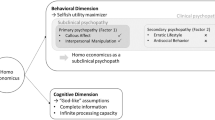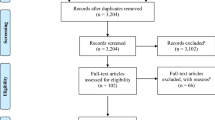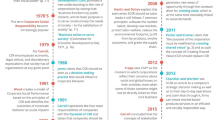Abstract
This study explores the aspects of the relationship between possible indicators of CEO narcissism and fraud. Highly narcissistic CEOs undertake challenging or bold actions to obtain frequent praise and admiration. The pursuit of narcissistic supply may result in a stronger likelihood of a CEO to undertake bold actions with potential detrimental consequences for the organization. The sample consists of all S&P 500 CEOs from 1992 till 2008 with more than 3 years of tenure. The measurement of CEO narcissism is based on 15 objective indicators and fits the main conceptualization of narcissism. This data collection provides a score for all S&P 500 CEOs according to their narcissistic tendencies. The Accounting and Auditing Enforcement Releases on the SEC’s website are the indicators of managerial fraud. The findings confirm the expected influence of plausible proxies for CEO narcissism on fraud by showing a positive relationship. This confirms the psychologic perspective of CEO narcissism as a potential cause of fraud.
Similar content being viewed by others
References
Adams, R. B., Almeida, H., & Ferreira, D. (2005). Powerful CEOs and their impact on corporate performance. Review of Financial Studies, 18(4), 1403–1432.
AICPA. (2002). Statement on Auditing Standards (SAS) No. 99: Consideration of fraud in a financial statement audit. New York: AICPA.
American Psychiatric Association and American Psychiatric Association. Task Force on DSM-IV. (2000). Diagnostic and statistical manual of mental disorders: DSM-IV-TR. American Psychiatric Publishing, Inc.
Amernic, J. H., & Craig, R. J. (2010). Accounting as a facilitator of extreme narcissism. Journal of Business Ethics, 96(1), 79–93.
Ashforth, B. E., & Anand, V. (2003). The normalization of corruption in organizations. Research in Organizational Behavior, 25, 1–52.
Baucus, M. S. (1994). Pressure, Opportunity and predisposition: A multivariate model of corporate illegality. Journal of Management, 20(4), 699–721.
Beasley, M. S., Carcello, J., & Hermanson, D. (1999). COSO’s new fraud study: What it means for CPAs. Journal of Accountancy, 187(5), 12–13.
Bebchuk, L. A., & Fried, J. (2006). Pay without performance: The Unfulfilled Promise of Executive Compensation. Cambridge: Harvard University Press.
Brooks, C. (2008). Introductory econometrics for finance. Cambridge: Cambridge University Press.
Brown, A. D. (1997). Narcissism, identity, and legitimacy. Academy of Management Review, 22, 643–686.
Buss, D. M., & Chiodo, L. M. (1991). Narcissistic acts in everyday life. Journal of Personality, 59(2), 179–215.
Chatterjee, A., & Hambrick, D. C. (2007). It’s all about me: Narcissistic chief executive officers and their effects on company strategy and performance. Administrative Science Quarterly, 52(3), 351–386.
Chen, S. (2010). The role of ethical leadership versus institutional constraints: A simulation study of financial misreporting by CEOs. Journal of Business Ethics, 93, 33–52.
Chen, C. C., & Meindl, J. R. (1991). The construction of leadership images in the popular press: The case of Donald Burr and People Express. Administrative Science Quarterly, 36(4), 521–551.
Child, J. (1972). Organizational structure, environment and performance: The role of strategic choice. Sociology, 6(1), 1–22.
Cohen, J., Ding, Y., Lesage, C., & Stolowy, H. (2010). Corporate fraud and managers’ behavior: Evidence from the press. Journal of Business Ethics, 95, 271–315.
Committee of Sponsoring Organizations (COSO) of the Tread Way Commission (1999) Fraudulent financial reporting: 1987–1997, an analysis of U.S. public companies. COSO.
Conger, J. A. (1990). The dark side of leadership. Organizational Dynamics, 19(2), 44–55.
Daily, C. M., & Johnson, J. L. (1997). Sources of CEO power and firm financial performance: A longitudinal assessment. Journal of Management, 23(2), 97–117.
Dechow, P., Ge, W., & Schrand, C. (2010). Understanding earnings quality: A review of the proxies, their determinants and their consequences. Journal of Accounting and Economics, 50(2–3), 344–401.
Duchon, D., & Drake, B. (2009). Organizational narcissism and virtuous behavior. Journal of Business Ethics, 85(3), 301–308.
Ellis, H. (1898). Auto-eroticism: A psychological study. Alienist and Neurologist, 19, 260–299.
Emmons, R. A. (1984). Factor analysis and construct validity of the narcissistic personality inventory\. Journal of Personality Assessment, 48(3), 291–300.
Emmons, R. A. (1987). Narcissism: Theory and measurement. Journal of Personality and Social Psychology, 52(1), 11–17.
Fortune (July 1, 1991). Chief Executives as Idi Amin?. http://mba.tuck.dartmouth.edu/pages/faculty/ken.french/Data_Library/det_12_ind_port.html.
Francis, J., Huang, A. H., Rajgopal, S., & Zang, A. Y. (2008). CEO reputation and earnings quality. Contemporary Accounting Research, 25(1), 109–147.
Freud, S. (1914). On narcissism: An introduction. Standard Edition, 14, 73–102.
Gompers, P., Ishii, J., & Metrick, A. (2003). Corporate governance and equity prices. Quarterly Journal of Economics, 118(1), 107–155.
Gottfredson, M. R., & Hirschi, T. (1990). A general theory of crime. Stanford: Stanford University Press.
Grossman, S. J., & Hart, O. D. (1983). An analysis of the principal-agent problem. Econometrica, 51(1), 7–45.
Hambrick, D. C., & D’Aveni, R. A. (1992). Top team deterioration as part of the downward spiral of large corporate bankruptcies. Management Science, 38(10), 1445–1466.
Hambrick, D. C., & Fukutomi, G. D. S. (1991). The seasons of a CEO’s tenure. The Academy of Management Review, 16(4), 719–742.
Harrison, J. R., Torres, D. L., & Kukalis, S. (1988). The changing of the guard: Turnover and structural change in the top-management positions. Administrative Science Quarterly, 33(2), 211–232.
Hayward, M. L. A., & Hambrick, D. C. (1997). Explaining the premiums paid for large acquisitions: Evidence of CEO hubris. Administrative Science Quarterly, 42(1), 103–127.
Higgs, M. (2009). The good, the bad and the ugly: Leadership and narcissism. Journal of Change Management, 9(2), 165–178.
Hogan, C. E., & Wilkins, M. S. (2008). Evidence on the audit risk model: Do auditors increase audit fees in the presence of internal control deficiencies? Contemporary Accounting Research, 25(1), 219–242.
Howell, J. M., & House, R. (1992). Socialized and personalized charisma: An essay on the bright and dark sides of leadership. Unpublished manuscript.
Humphreys, J., Zhao, D., Ingram, K., Gladstone, J., & Basham, L. (2010). Situational narcissism and charismatic leadership: A conceptual framework. Journal of Behavioral Applied Management, 11(2), 118–136.
Jensen, M. C. (1993). The modern industrial revolution, exit, and the failure of internal control systems. Journal of Finance, 48(3), 831–880.
Jensen, M. C., & Meckling, W. H. (1976). Theory of the firm: Managerial behavior, agency costs and ownership structure. Journal of Financial Economics, 3(4), 305–360.
Jensen, M. C., & Murphy, K. J. (1990). Performance pay and top-management incentives. Journal of Political Economy, 98(2), 225–264.
Jørstad, J. (1996). Narcissism and leadership: Some differences in male and female leaders. Leadership & Organization Development Journal, 17(6), 17–23.
Kaptein, M. (2008). Developing a measure of unethical behavior in the workplace: A stakeholder perspective. Journal of Management, 45, 978–1008.
Kernberg, O. F. (1975). Borderline conditions and pathological narcissism. New York: J. Aronson.
Kets de Vries, M. F. R. (2001). The leadership mystique: A users manual for the human enterprise. Harlow: Financial Times Prentice Hall.
Kets de Vries, M. F. R. (2004). Organizations on the couch: A clinical perspective on organizational dynamics. European Management Journal, 22(2), 183–200.
Kets de Vries, M. F. R. (2006). The leader on the couch: A clinical approach to changing people and organizations. Hoboken: Wiley.
Kets de Vries, M. F. R., & Balazs, K. (2011). The shadow side of leadership. The SAGE handbook of leadership (p. 380). London: Sage.
Kets de Vries, M. F. R., & Miller, D. (1984). Neurotic style and organizational pathology. Strategic Management Journal, 5(1), 35–55.
Kets de Vries, M. F. R., & Miller, D. (1985). Narcissism and leadership: An object relations perspective. Human Relations, 38(6), 583–601.
Kish-Gephart, J. J., Harrison, D. A., & Trevino, L. K. (2010). Bad apples, bad cases, and bad barrels: Meta-analytic evidence about sources of unethical decisions at work. Journal of Applied Psychology, 95(1), 1–31.
Kohut, H. (2009). The restoration of the self. Chicago: University of Chicago Press.
Langabeer, J. R., I. I., & DelliFraine, J. (2011). Does CEO optimism affect strategic process? Management Research Review, 34(8), 857–868.
Lasch, C. (1979). The culture of narcissism: American life in an age of diminishing expectations. New York: Norton.
Lazear, E. P., & Rosen, S. (1981). Rank-order tournaments as optimum labor contracts. Journal of Political Economy, 89(5), 841–864.
Lubit, R. (2002). The long-term organizational impact of destructively narcissistic managers. The Academy of Management Executive (1993), 16(1), 127–138.
Maccoby, M. (2000). Narcissistic leaders: The incredible pros, the inevitable cons. Harvard Business Review, 78(1), 68–78.
Maccoby, M. (2001). Narcissistic leaders. In Anonymous, W. E. Rosenbach, & R. L. Taylor (Eds.), Contemporary issues in leadership (pp. 281–295). Cambridge: Massachusetts Westview Press.
Maccoby, M. (2003). The productive narcissist: The promise and peril of visionary leadership. New York: Broadway.
Mace, M. L. (1971). Directors: Myth and reality. Boston: Harvard University Press.
Malmendier, U., & Tate, G. (2008). Who makes acquisitions? CEO overconfidence and the market’s reaction. Journal of Financial Economics, 89(1), 20–43.
Malmendier, U., & Tate, G. (2009). ‘Superstar CEOs. Quarterly Journal of Economics, 124(4), 1593–1638.
Milbourn, T. T. (2003). CEO reputation and stock-based compensation. Journal of Financial Economics, 68(2), 233–262.
Miller, D. (1991). Stale in the saddle: CEO tenure and the match between organization and environment. Management Science, 37(1), 34–52.
Millon, T. (1981). Disorders of personality: DSM-III, Axis II. New York: Wiley.
Morck, R., Shleifer, A., & Vishny, R. W. (1990). Do managerial objectives drive bad acquisitions? Journal of Finance, 45(1), 31–48.
Padilla, A., Hogan, R., & Kaiser, R. B. (2007). The toxic triangle: Destructive leaders, susceptible followers, and conducive environments. The Leadership Quarterly, 18, 176–194.
Paulhus, D. L., & Williams, K. M. (2002). The dark triad. Journal of Research in Personality, 36, 556–563.
Rajgopal, S., Shevlin, T., & Zamora, V. (2006). CEOs’ outside employment opportunities and the lack of relative performance evaluation in compensation contracts. Journal of Finance, 61(4), 1813–1844.
Raskin, R. N., & Hall, C. S. (1979). A narcissistic personality inventory. Psychological Reports, 45(2), 590.
Raskin, R., Novacek, J., & Hogan, R. (1991). Narcissistic self-esteem management. Journal of Personality and Social Psychology, 60(6), 911–918.
Raskin, R., & Terry, H. (1988). A principal-components analysis of the narcissistic personality inventory and further evidence of its construct validity. Journal of Personality and Social Psychology, 54(5), 890–902.
Rosenthal, S. A., & Pittinsky, T. L. (2006). Narcissistic leadership. The Leadership Quarterly, 17(6), 617–633.
Sankowsky, D. (1995). The charismatic leader as narcissist: Understanding the abuse of power. Organizational Dynamics, 23(4), 57–71.
Schrand, C. M., & Zechman, S. L. C. (2009). Executive overconfidence and the slippery slope to fraud. SSRN eLibrary.
Schwartz, H. S. (1991). Narcissism project and corporate decay: The case of general motors. Business Ethics Quarterly, 1, 249–268.
Schweitzer, M. E., Ordonez, L., & Douma, B. (2004). Goal setting as a motivator of unethical behavior. Academy of Management Journal, 47(3), 422–432.
Wallace, H. M., & Baumeister, R. F. (2002). The performance of narcissists rises and falls with perceived opportunity for glory. Journal of Personality and Social Psychology, 82(5), 819–834.
Weisbach, M. S. (1988). Outside directors and CEO turnover. Journal of Financial Economics, 20(1), 431–460.
Yermack, D. (2006). Flights of fancy: Corporate jets, CEO perquisites, and inferior shareholder returns. Journal of Financial Economics, 80(1), 211–242.
Zahra, S. A., Priem, R. L., & Rasheed, A. A. (2005). The antecedents and consequences of top management fraud. Journal of Management, 31(6), 803–828.
Author information
Authors and Affiliations
Corresponding author
Rights and permissions
About this article
Cite this article
Rijsenbilt, A., Commandeur, H. Narcissus Enters the Courtroom: CEO Narcissism and Fraud. J Bus Ethics 117, 413–429 (2013). https://doi.org/10.1007/s10551-012-1528-7
Received:
Accepted:
Published:
Issue Date:
DOI: https://doi.org/10.1007/s10551-012-1528-7




